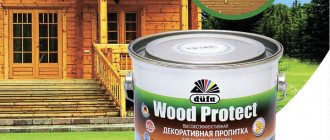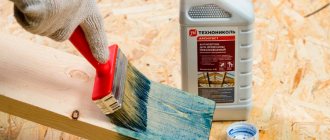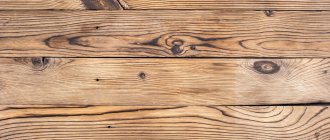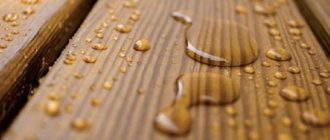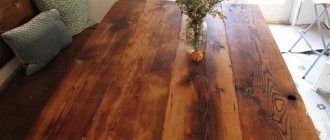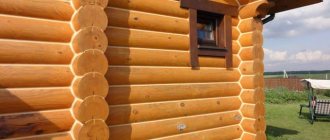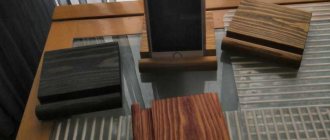- The need for fire protection when building houses
- Types of impregnation
- Compositions and properties
- Methods of processing structures and material consumption
- How to choose impregnation
Natural wood is one of the most popular building materials on the market today.
Its popularity is explained by its ease of processing, aesthetics, durability and excellent thermal insulation. Wood also has disadvantages, for example, the risk of fire. However, fire-prevention impregnation of wood can significantly reduce the likelihood of a fire occurring and spreading. Today we will talk in detail about fire retardant compounds, look at the most popular ones and try to choose the best one.
The need for fire protection when building houses
The need for fire protection for wood is not only obvious, but also enshrined in many modern regulatory documents, which must be observed in order to put a structure into operation.
Building codes regulate the frequency and conditions under which wood must be treated with fire retardant compounds:
- before putting into operation;
- every 5 years of use;
- if necessary to maintain the required level of security.
To determine the need for fire retardant treatment, you can remove a small amount of shavings and set them on fire. If a fire occurs, the wood needs special protection.
The standards also contain a list of building elements that require special fire retardant treatment. These include:
- rafter structures;
- timber walls;
- floors;
- beams;
- wooden panels;
- shingles under plaster, etc.
Types of impregnation
All protective impregnation options can be divided into several types according to protection class:
- Highest protection. Thanks to this impregnation, wood can resist fire for more than 2.5 hours and, under the influence of an open flame, loses no more than 10% of its weight.
- Average. When exposed to flame, wood can lose no more than 25% of its mass and can resist fire for up to 1.5 hours.
- Minimal. Mass loss under the influence of fire is up to 85%.
Fire retardant compounds of the first group are mainly used in places and on structures with an increased risk of fire.
According to their chemical composition, protective substances are:
- saline;
- acidic;
- alkaline.
There is also a classification of protective substances based on their composite composition.
Let's take a closer look at each type.
Fire retardants
Basic flame retardants that are often used in other types of formulations, including varnishes and paints. Fire retardants are organically soluble and water-soluble.
Organically soluble substances are characterized by increased resistance to external factors (water, dampness, temperature fluctuations), therefore they are mainly used for treating structures that may be subject to various negative influences during operation.
Water-soluble ones are not highly resistant, so they are used to treat structures that are not exposed to moisture.
Paints
Most often, protective paints include flame retardants and coloring pigments. According to their mechanism of action, they are:
- Intumescent. First security group. Under the influence of high temperature, the paint layer bubbles, increases in volume up to 30 times and creates reliable protection against fire.
- No swelling. Produced using silicates. Under the influence of flame, a durable glass-like layer is formed on the surface of the wood, protecting the wood.
There are paints on the market designed for indoor and outdoor use.
Lucky
Universal protective substances used indoors. Varnishes not only increase the safety of the building, but also ensure that the decorative qualities of the wood are revealed.
Can be used on different surfaces:
- walls;
- partitions;
- floor;
- furniture, etc.
Impregnations, pastes
Impregnations are used to deeply affect wood. They penetrate the fibers and provide reliable fire protection. A layer of cladding, such as paint or varnish, can be applied on top of the impregnation.
Pastes provide reliable protection when applied in a thick layer. The recommended layer thickness is 2 cm. Since their use violates the aesthetic qualities of wood, pastes are used in places hidden from human eyes, for example, in the attic or under the sheathing.
The role of fire retardants in wooden house construction
Fireproof materials are available in different forms - in the form of varnish, paint, mastic, paste, liquid impregnation. A large selection of types of fire retardants makes it possible to process both lumber and finished structures.
For example, after drying in a steaming chamber, profiled timber is sent to an autoclave, where negative pressure is created. This removes air bubbles from the pores. After this, maintaining a vacuum, the chamber with the beam is filled with a fire retardant substance. Under the influence of excess hydraulic pressure, the liquid easily penetrates the structure of the material, covering its surface and sealing the pores.
Of course, it is most reliable to use already prepared lumber, but if this is not possible, then fire protection can be carried out after construction is completed. During the construction process, lumber is processed only in those places that will then be inaccessible later, for example, grooves in logs. The main part of the fire protection work is carried out after the box has been assembled, the roof has been covered, and windows and doors have been installed.
In domestic conditions, liquid impregnations are applied to boards or structures using:
- spray, brush or roller;
- by immersion in a container filled with a special liquid.
These methods do not guarantee long-term fire protection, since the inhibitor remains only on the surface and does not penetrate deep into the structure. But even such protection can reduce the risk of fire - when untreated structures catch fire, only 14-18 minutes pass from the appearance of through cracks to the complete collapse of the ceilings. It has been experimentally proven that load-bearing structures and elements treated with fire protection ignite and burn more slowly. In this case, from the start of the fire to the moment of collapse, it takes from 40 to 50 minutes. This time is enough to take measures to extinguish the fire, evacuate people in the building, and save valuable property.
During the operation of a house, bathhouse and outbuilding made of timber or logs, it is recommended to regularly treat it with fire retardant impregnations. The frequency of treatment depends on the shape and type of fire protection.
Important! When it comes to fire protection of composites that contain shavings or sawdust, substances that prevent ignition are introduced into them at the manufacturing stage. As a rule, re-treatment of structures and coatings made of WPC, planken, decking, parquet, and gusvarblock is not required.
What flame retardants should you choose?
The choice of fire retardant compounds is carried out taking into account the grade, type, and density of wood. For example, oak lights up rather slowly even without additional protection, but spruce or pine boards burn out within a few minutes.
When choosing the type of protection you need to consider:
- Fire protection group. She could be the first or the second. For the first group, the maximum limit for material weight loss, established during the testing process, is only 8-10%, for the second - up to 25%.
- Compatible with paints and varnishes. The use of first-generation acid-based inhibitors made the use of paints and varnishes impossible. That is why they were produced in several colors. Modern water-based fire retardants are characterized by good compatibility with the decorative topcoat that is applied over impregnations.
- Color. When using clear varnishes as a decorative coating, it is very important how much the inhibitor hides the wood texture. It can form an opaque film or, on the contrary, slightly tint, emphasizing its natural beauty.
- Method of application, consumption, regularity of use. Some fireproof impregnations have an unlimited shelf life, others can be stored for no more than 25-30 days. These factors are key when calculating the required amount of impregnation solution.
- Life time. Plank buildings will have to be regularly treated with impregnating solutions. Depending on the brand of inhibitor, the frequency of treatment is once a year or once every three years.
Compositions and properties
Fire retardant properties of impregnations and other materials are provided by special protective substances, very often nitric acid, sulfuric acid and ammonium salts.
Under the influence of high temperature, a chemical reaction begins, as a result of which a layer of non-combustible material is formed on the surface of the wood. In addition, the chemical reaction is accompanied by the release of gases that prevent the wood from burning.
Phosphorus and halogen atoms are often used as a basis for creating organosoluble compounds. In the production of water-soluble impregnations, phosphate acids are used, including monoammonium, diammonium phosphate, etc.
High-quality impregnations do not harm wood and ensure that the technical characteristics of the material are maintained even in the event of a fire.
Fire retardant compounds will not be able to protect against arson committed using flammable solutions.
Types and composition of fire retardants
Fire retardants are substances that prevent ignition and combustion, prevent flames from spreading, and promote self-extinguishing of fire.
The composition of fire retardants for processing includes:
- Flame retardants. This category includes ammonium chloride, phosphate and borate, and phosphoric acid.
- Synergists. This group includes substances that enhance the effect of inhibitors.
- Stabilizers. Substances of this group are needed to limit the consumption of moderators.
Depending on the principle of action, fire retardants are of two types:
- Saline. Liquids for impregnating wood contain fusible salts, which have the ability to increase the combustion temperature. These are salts of boric, silicic and orthophosphoric acids - borates, silicates, phosphates. In this case, the generated heat is spent on melting the fire retardant itself, and not the material with which it is impregnated. Treated wood ignites much later than untreated wood. In addition, it requires a higher temperature to ignite.
- Salt-free. Fire retardants of the second group have the property of releasing non-flammable gases when heated. They change the composition of the air, displacing oxygen, which is necessary for combustion. When wood treated with this impregnation ignites, the fire does not spread - the fire goes out on its own. Such impregnations include sulfuric acid gases - ammonium sulfate and ammonia.
Fire retardant materials can be used individually or be part of a combined product that acts comprehensively. Such impregnations are the most effective.
Note. In addition to the ability to self-extinguish and increase the ignition temperature, fire retardant compounds swell when suddenly heated, forming a crust on the surface that blocks the access of oxygen and prevents the spread of fire.
Methods of processing structures and material consumption
Treatment of wood against fire can be deep and moderate. The second option is more often used in the construction of private houses, as it involves less material consumption and easier application, which significantly reduces costs.
Deep processing involves applying the compositions using a hot-cold bath technique or in a special autoclave:
- In the bath. Warming up the wood alternates with cooling in a cold bath.
- In an autoclave. Vacuum application of fire retardant compounds under pressure.
When applying a fire-retardant composition, it is imperative to comply with the requirements specified in the manufacturer’s instructions.
Material consumption depends on the required protection group and chemical composition. If salt impregnation is used, then to ensure the second protection group it is necessary to apply at least 300 g of the substance per 1 m2 of wood surface.
To ensure compliance with the first group, even more material is required - at least 600 g.
How to choose impregnation
There is a wide range of fire-fighting substances on the market. In order not to make a mistake with your choice, you need to take into account several important nuances:
- The substance should not adversely affect the mechanical and hygroscopic properties of wood.
- It is better to choose the safest composition for the health of people and animals.
- Water-based impregnations require additional drying after application so that it does not lead to deformation of the wood.
- Each impregnation has an indicator of atmospheric resistance - the higher it is, the longer the gap between treatments may be during the operation of the house.
- It is recommended to use substances from the same manufacturer, since compositions from different companies may enter into negative chemical reactions.
- The composition must be certified by the Ministry of Health and Social Development of Russia.
When choosing an impregnation, professionals do not recommend chasing foreign compounds. Domestic substances show no worse reliability and are able to provide wood with excellent protection when used correctly.
The Render House company is engaged in the construction of turnkey country houses and carries out fire-prevention impregnation of wood at the stage of construction of the cottage. You can view typical projects on the website.
Recipes for fire retardants for wood that you can make yourself.
1) Diammonium phosphate: kerosene contact: water, in appropriate proportions 25: 3: 72. It is enough to treat the surface twice with this fire retardant.
2) Borax:boric acid:water, in the appropriate proportion 2:3:95
3) Soak the wood with a 14% borax solution. Dry. And treat the top with a 20% zinc chloride solution.
The presented compositions meet the following requirements for fire retardants:
- Does not reduce the mechanical qualities of wood
- Does not destroy the adhesive
- Prevents fire for up to 15 minutes
- Does not cause corrosion of metal elements
- Do not have a harmful effect on the human or animal body
- Impregnation does not cause cracking of wood
